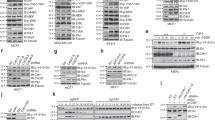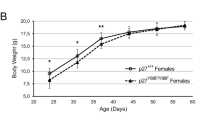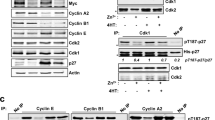Abstract
The oncogenic Bcr-Abl variant of the c-Abl tyrosine kinase transforms cells by a mechanism dependent on activation of the stress-activated protein kinase (SAPK). Other work has shown that c-Abl interacts with the SHPTP1 protein tyrosine phosphatase in induction of SAPK activity by genotoxic stress. The present studies demonstrate that Bcr-Abl binds constitutively to SHPTP1. We show that Bcr-Abl phosphorylates SHPTP1 on C-terminal Y536 and Y564 sites. The functional significance of the Bcr-Abl/SHPTP1 interaction is supported by the finding that SHPTP1 regulates Bcr-Abl-induced SAPK activity. Importantly, SHPTP1 also decreases Bcr-Abl-dependent transformation of fibroblasts. These findings indicate that SHPTP1 functions as a tumor suppressor in cells transformed by Bcr-Abl.
This is a preview of subscription content, access via your institution
Access options
Subscribe to this journal
Receive 50 print issues and online access
$259.00 per year
only $5.18 per issue
Buy this article
- Purchase on Springer Link
- Instant access to full article PDF
Prices may be subject to local taxes which are calculated during checkout
Similar content being viewed by others
Author information
Authors and Affiliations
Rights and permissions
About this article
Cite this article
Liedtke, M., Pandey, P., Kumar, S. et al. Regulation of Bcr-Abl-induced SAP kinase activity and transformation by the SHPTP1 protein tyrosine phosphatase. Oncogene 17, 1889–1892 (1998). https://doi.org/10.1038/sj.onc.1202117
Received:
Revised:
Accepted:
Published:
Issue Date:
DOI: https://doi.org/10.1038/sj.onc.1202117
Keywords
This article is cited by
-
CIP2A is overexpressed and involved in the pathogenesis of chronic myelocytic leukemia by interacting with breakpoint cluster region-Abelson leukemia virus
Medical Oncology (2014)
-
Protein phosphatase 2A (PP2A), a drugable tumor suppressor in Ph1(+) leukemias
Cancer and Metastasis Reviews (2008)
-
ReSETting PP2A tumour suppressor activity in blast crisis and imatinib-resistant chronic myelogenous leukaemia
British Journal of Cancer (2006)
-
Phosphorylation of tyrosine 393 in the kinase domain of Bcr-Abl influences the sensitivity towards imatinib in vivo
Leukemia (2003)
-
Role of the tyrosine phosphatase SHP-1 in K562 cell differentiation
Leukemia (2001)



